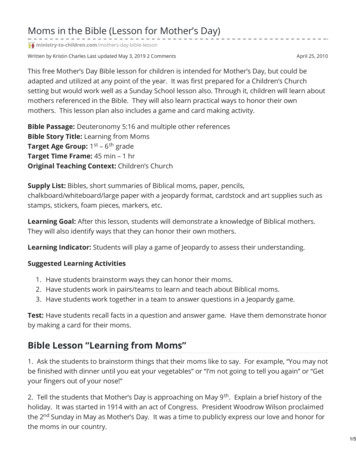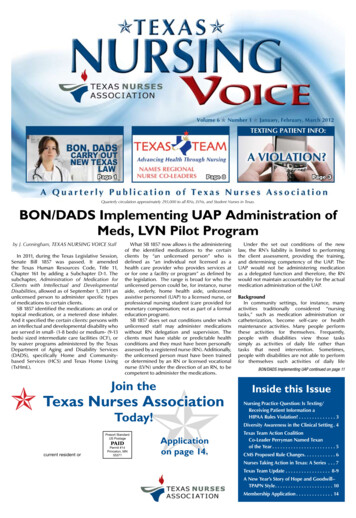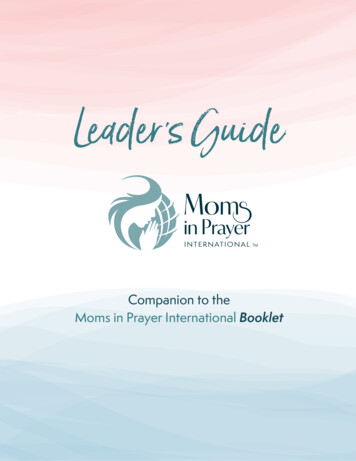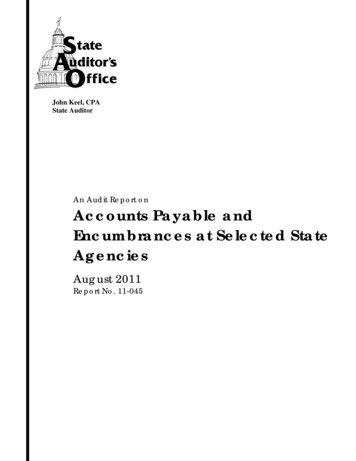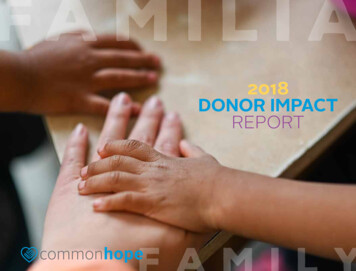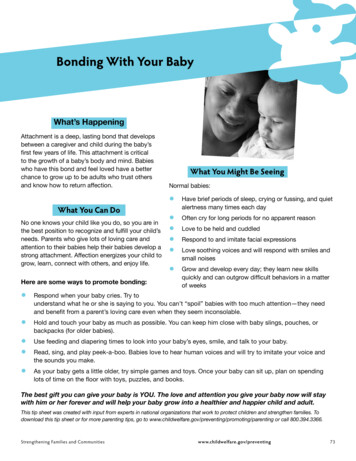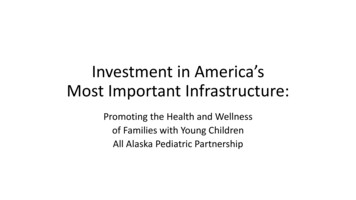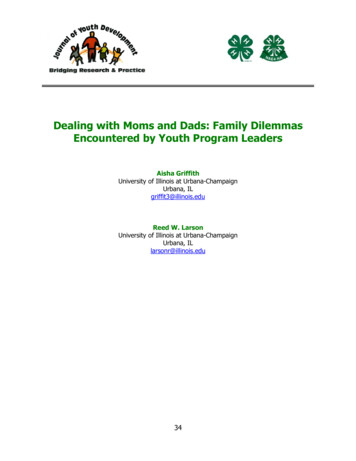
Transcription
Dealing with Moms and Dads: Family DilemmasEncountered by Youth Program LeadersAisha GriffithUniversity of Illinois at Urbana-ChampaignUrbana, ILgriffit3@illinois.eduReed W. LarsonUniversity of Illinois at Urbana-ChampaignUrbana, ILlarsonr@illinois.edu34
Volume 9, Number 2, Summer 2014Article 140902FA003Dealing with Moms and Dads: Family DilemmasEncountered by Youth Program LeadersAisha Griffith and Reed W. LarsonUniversity of Illinois at Urbana-ChampaignAbstract: The leaders of youth programs encounter a range ofchallenging situations that involve youth’s parents or families. Thisqualitative study obtained data on the variety and nature of thesefamily-related “dilemmas of practice.” Longitudinal interviews withleaders of 10 high quality programs for high-school-aged youthyielded narrative information on a sample of 32 family dilemmasthat they had encountered. Grounded theory analysis identified fourcategories of family dilemmas: 1) problems at home that become aconcern to the leader, 2) parents’ expectations are incongruent withprogram norms or functioning, 3) parents do not support youth’sparticipation in the program or an aspect of the program, and 4)communicating with parents on sensitive matters. Each of thesecategories of dilemmas entailed distinct considerations andunderlying issues that effective leaders need to be able tounderstand.IntroductionParents of young people in youth development programs are generally supportive of theirchildren’s participation. They endorse the developmental goals of the program; often play a rolein encouraging their child to join (Furstenberg, et al., 1999; Hutchinson, Baldwin, & Caldwell,2003; Jarrett, 1995); and provide support for the program to the child at home (Kang, Raffaelli,& Tran, 2012). Nonetheless there are occasions when program leaders may encounter tensions,challenging issues, or dilemmas in the program that relate to youth’s families. These caninclude parents’ intrusiveness in program activities (Smoll, & Cumming, 2006), family issuesthat compromise a youth’s participation (Larson, & Walker, 2010), and other types of situations.It is important that program leaders understand and develop skills for dealing with the range offamily dilemmas that can arise.Walker and Walker (2012) have advocated discussion and analysis of “practitioner dilemmas” asa vital component to the training of youth professionals. A dilemma is a decision-making35
situation that has no clear cut response and requires practitioners to contemplate complex orcompeting issues (Banks, 2010; Larson, & Walker, 2010). Dilemmas related to youth’s familiescan be particularly difficult because leaders often have little direct contact with them. Whathappens at home is often opaque and beyond one’s control. Yet parents and other familymembers exert considerable influence on youth that affects youth’s program participation orcan be a concern because of its effect on a youth’s well-being.The data for this examination of family dilemmas come from a longitudinal study of 10programs that serve ethnically diverse high-school-aged youth. Our first aim is to describe thevariety of family dilemmas encountered by the leaders of these programs, including theconsiderations they entailed. Across fields of practice, identifying the variety of problems thatpractitioners are called upon to address is vital to the development of the field (Ericsson, 2006).Our second aim is analysis and interpretation of the underlying issues at stake in the differenttypes of dilemmas. Interpretative thinking –monitoring events, assessing situations, andpredicting the course of unfolding events– is a critical element of youth practitioners’ work(Larson, Walker, Rusk, & Diaz, submitted). This study is a response to a call for “use inspired”research, aimed at contributing findings, frameworks, and training materials that are helpful toyouth practitioners’ daily work of supporting youth development (Tseng, 2012).Literature ReviewDilemmas and the Considerations They EntailExpertise in any field of practice entails being able to evaluate and respond to the array ofchallenging decision-making situations that arise (Ericsson, et al., 2006; Simon, 1996). Thesesituations are often complex, multi-layered and dynamic. Case studies are often employed as avaluable means for both understanding and teaching practitioners about these dilemmasituations (Harrington, 1995; Levin, 1994).Preliminary research indicates that the dilemma situations encountered by youth programleaders can be quite complex. They often entail multiple considerations – multiple issues that aprogram leader must take into account in appraising and responding to it. These can includedevelopmental, pragmatic, professional, and ethical considerations (Banks, 2010; Larson, &Walker, 2010). In some cases these different considerations can be in tension with each other.An important finding is that program leaders identified as “experts” by their supervisors havebeen found to identify significantly more considerations (and more diverse consideration) thannovice program leaders and their responses are more likely to address more of theseconsiderations (Walker, & Larson, 2012). This finding suggests that research identifyingpatterns in dilemmas can contribute to the field and to practitioner training.The dilemmas encountered by youth program leaders are wide ranging. Larson and Walker(2010) obtained a database of 250 dilemma situations encountered by frontline programleaders and categorized the considerations they entailed into five broad psycho-social ecologicaldomains (and sub domains within each). The five included running activities, cultivating andenforcing norms and rules, youth’s personalities and relationships with each other, relationshipsamong program staff, and the interface between the program and external worlds (Larson, &Walker, 2010). The final domain of dilemmas (interface with external worlds) included a subsetthat involved youth’s families.36
Family DilemmasFamily dilemmas are important. Parents influence a youth’s initial decision to join a programand can influence their decision to quit; parents may also set rules or place demands on youthand the nature of their participation (Borden, Perkins, Villarruel, & Stone, 2005; Fletcher, Elder,& Mekos, 2000; Perkins, Borden, Villarruel, Carlton-Hug, Stone, & Keith, 2007). Parents are alsoimportant because, when they favor youth’s participation, they often provide valuable supportthat enhances youth’s engagement and learning, including encouragement, transportation, andreinforcement of learning (Kang, et al., 2012). Thus leaders need to be judicious in how theyrespond to situations involving youth’s families.There are many reasons family dilemmas could arise for leaders of programs for adolescents. Insome cases parents’ values diverge from those of the program, a situation that may be morecommon among immigrant families (Larson, Pearce, Sullivan, & Dawes, 2007). Another type ofdilemma situation, reported in the literature on youth sports, is when parents are overinvolvedin ways that can interfere with youth’s experiences (Côté, & Hay, 2002; Hutchinson, et al.,2003).Further, an adolescent’s experience within his/her family may also impact a youth’s experiencein a program and become a concern to program leaders. The nature and quality of a youth’srelationships with parents can influence an adolescent’s self-esteem, socio-emotionaladjustment, and their process of ethnic identity formation (Hale, Valk, Engels, & Meeus, 2005;Smetana, et al., 2006; Umaña-Taylor, Bhanot, & Shin, 2006). These may in turn become anissue within the program.Despite the many potential tension points between program and home, we are aware of noresearch that focuses on family dilemmas in youth programs (except in sports; Wiersma, &Fifer, 2008). Research on K-12 teachers has identified important family dilemma situationsrelated to communication, parental involvement, professionalism, culture, and family poverty(Crozier, 1999; Suarez-Orozco, & Suarez-Orozco, 2001; Weiss, Kreider, Lopez, & ChatmanNelson, 2005). It is important for youth professionals to become aware of how these or otherconsiderations are manifest in youth programs.The Current StudyThe goal of this study was to systematically explore the family dilemmas leaders encounter. Theanalyses addressed two aims. The first was descriptive: to identify the types of family dilemmas encountered byprogram leaders and the considerations associated with each. The second was interpretive: to examine the underlying pragmatic and theoreticalchallenges that leaders faced within these dilemmas. What are the underlying issues atstake in the different types of family dilemmas?This investigation focused on leaders of high quality programs serving adolescents. Weemployed the data set used by Larson and Walker (2010), which provided a rich source ofuntapped data on family dilemmas. As noted above, expert program leaders have been foundto identify more considerations in dilemmas situation. We felt that use of data from high qualityprograms would allow us to benefit from effective leaders’ deeper, more nuanced appraisal ofthe family situations they encountered. Grounded theory and related qualitative researchmethods were employed for this study because they are better suited to understanding thecomplexity of practice in context.37
MethodsSampleThe data came from the principal program leaders at 10 high quality programs serving urbanand rural youth. The programs included those with a focus on arts, technology, leadership, andservice. They varied in size from 10 to 110 youth members (ages ranged from 13-21). Youth inthe programs were White, African American, and Latino. The programs were identified as “highquality” based on the opinions of youth development experts in the community, researchers’meetings with staff, and observations of the programs (following steps used by McLaughlin,Irby, & Langman, 1994). The original research included 12 programs (Larson, & Walker, 2010),but we have included only the 10 in which leaders reported at least one family dilemma.The current study included all primary program adult leaders (n 14) from the 10 programs.Programs had one to two primary adult leaders. Table 1 provides information on the primaryadult leaders. All primary adult leaders were paid professional staff and had been working attheir programs for at least two years. The majority of adult leaders were between the ages of25-35. They were primarily European and African American.Table 1Primary Adult Leaders in SamplePrimary Adult Leader Information(Age, Ethnicity, Years in position, Degree)FFA AdviserFFA AdviserManager of Collegeand Career ProgramLead Organizer30-35, European American, 9 yrs, BA-Education30-35, European American, 9 yrs, BA-Education25-30, European American, 2 yrs, MA-Social Work40-45, European American, 9 yrs, BA-Music Ed50-55, European American, 30 yrs, BA-SpeechCommunication & English Education; MA-TheaterHistory40-45, African American, 2 yrs, BA-Criminal JusticeN ofInterviewsPosition of Primary AdultLeadersN ofDilemmasName 717Theater DirectorProducerFaith inMotionMediaMastersThe Studio16Youth Adult Leader210415Media InstructorMedia InstructorProgram CoordinatorClarkstonFFAArt First25-30, Arab American, 8 yrs, MA-TeachingHarambee111Program Director25-30, East Indian, 4 yrs, BA-Art & Technology25-30, European American, 2 yrs, BA-Unknown25-30, African American, 3 yrs, Recording StudioSchool30-35, African American, 4 yrs, MA-HumanResources25-30, European American, 5 yrs, MA-Social WorkEl Concilio28Outreach & Activities Director30-35, Puerto Rican, 3 yrs, BA-UnknownSisterHood214Program Coordinator25-30, European American, 3 yrs, BA-Women’sStudies20-25, African American, 3 yrs, EducationUnknownEmployment SpecialistProgram Coordinator38
ProceduresThe program leaders were interviewed at 4-8 points in time over a natural period of programparticipation, ranging from 2-9 months. In total 114 interviews were conducted with the programleaders in the sample. The leader data were enhanced by program documents, interviews withyouth (8-13 youth per program were interviewed following the same interview schedule), andparticipant observations. All interviews were recorded and transcribed verbatim.Interview ProtocolNearly all of the dilemma situations used in the analysis were identified from the leader interviews.Interview protocols included open-ended questions about dilemmas they faced, how they decidedto handle such dilemmas and how they felt about their decisions. Additional information aboutthese situations was sometimes obtained from the youth interviews, when a youth was describinghis or her ongoing experiences in the program. Most of the data obtained described the nature ofthe dilemma situations, with less on how leaders responded.Family Dilemma Data SetThe operational definition used to identify dilemma situations was the following: “Challenges,dilemmas, situations and incidents that the adult leaders faced any situation that requiresdeliberation by adult leaders, or where different adult leaders might have responded in differentways. Some may involve long term struggles; others brief situations” (Larson, & Walker, 2010).The majority of family dilemma situations we identified were part of a previously constructed dataset of dilemmas identified by Larson and Walker (2010). We identified six additional situationsfrom reviewing transcripts of interviews with adult leaders. In total 32 family dilemmas wereidentified. Each dilemma situation was expanded by a methodical search of all interviews withleaders and youth for each and every reference to the dilemma situation.The data was organized in a database with a separate digital file for each dilemma situation. Thesecontained verbatim quotes about the situation, as well as family characteristics (such as ethnicity)of youth involved in that situation, and any notes from relevant program documents. As analysisproceeded a summary was written of each dilemma, and information on coding categorization andthe identification of considerations was added.Data AnalysisThe goal of the data analysis was to identify the types of dilemmas adult leaders described andhow adult leaders understood the family dilemmas that arose. Based on techniques in groundedtheory analysis, the first author engaged in a reciprocal process with the raw data, searched forpatterns, and then speculated about what the big ideas were. Throughout the iterative dataanalysis process, the second author who was thoroughly familiar with the data set and has usedgrounded theory methods provided feedback that helped refine, specify, and find patterns incategories. This process enabled us to move from a data realm into a conceptual realm and,finally, into a theoretical realm (Glaser, & Strauss, 1967). The data analysis involved three stagesthat progressed from description to analysis and interpretation.Stage one: constructing categories. The goal of the first stage of analysis was to identifycommon categories of family dilemmas. Comparative analysis was utilized (Hood, 2007). Weiteratively compared dilemma situations to one another to look for characteristics of dilemmas thatwere similar. At each iteration, written description of each emerging category was revised toreflect similarities and differences between dilemma situations.39
Four categories emerged that involved different types of dilemmas with parents or guardians(N 28). We decided to exclude four dilemma situations from further analysis (3 involving siblingsand 1 involving a youth’s own child) because there were too few to allow meaningful analysis. Inaddition, two dilemma situations that were classified into more than one category, were assignedto a primary category for the subsequent analysis. Table 2 provides brief descriptions of allsituations within each of the four categories. All names of program leaders, youth, and theprograms are pseudonyms.Table 2Dilemma Situations within Each CategoryDilemmaCategory1) Problems atHome thatBecome aConcern to theAdult LeaderDilemma Situation1) Luis is kicked out of house: youth complain he's spending lots of time at program (TheStudio)2) A girl has issues at home that disrupt her work at the program (Westville H.S.Thespians)3) Rafael asks the adult leader for advice about a conflict with his parents (Media Masters)4) Darryl has problems at home because his parents separated (The Studio)5) A youth confides in adult leader that she might be pregnant and cannot tell mother(SisterHood)6) A youth with special needs has a difficult home life including her mother being blind andliving in a shanty (Clarkston FFA)7) A youth may not be able to go to an important program event because her mother isupset about babysitting her daughter’s child all day (Youth Action)8) A boy has family problems that prevented him from completing required tech hours(Westville H.S. Thespians)2) Parents’Expectationsare Incongruentwith ProgramNorms orFunctioning1) Different parents want special privileges or treatment because they think their child isthe best (Westville H.S. Thespians)2) Mother is concerned when Mike is considering removing her daughter out of theprogram (Harambee)3) One youth's family uses her fundraising money for the program to pay bills; other youthcomplain (SisterHood)4) Parents protest that children are asked to come to practice when they're not needed(Westville H.S. Thespians)5) Premadonna’s mother questions why her daughter did not get a bigger role in the play(Westville H.S. Thespians)3) Parents donot SupportYouth’sParticipation inthe Program oran Aspect ofthe Program1) Elena's mother forbids her child from participating in the program after making a sceneat the program because she saw her daughter with her boyfriend (Youth Action)2) Parents don't understand the value of the program (Media Masters)3) Parents are against the program because they do not want their daughters hanging outwith boys (Youth Action)4) Parents feel that the program is a waste of time (Youth Action)5) Conservative parents take their child out of the program because they think it will havea negative influence on their child (El Concillo)6) Parents won’t let youth go on a trip to Venezuela with the program (Youth Action)7) Parents are concerned about their children going to the program because the programis in a neighborhood with gangs (Youth Action)8) Mother of a young lady’s baby’s father oppose a youth's participation because shethinks the youth should be at home with the baby or working at a job (El Concillo)9) Parents are uncomfortable with their children’s involvement in protest activities that arecarried out by program members (Youth Action)40
DilemmaCategory4)Communicating withparents onsensitivematters10) Some parents don’t understand or support the program; leader does not know all thereasons but believes parents feel it is another thing pulling youth away from theirschoolwork (Youth Action)Dilemma Situation1) Robert’s mother needs to know that her son's GPA falls below the required minimum tocontinue participating (Westville H.S. Thespians)2) Parents need to be informed about an upcoming protest the program is conducting(Youth Action)3) Rebecca must call David’s mother to explain that the special needs youth cannot be inthe program because of ability (Art First)4) Leader has information she could share with a parent who is also a friend about herdaughter dating a boy with a bad reputation (Westville H.S. Thespians)5) A mother informs the leader that youth are dating within the group which is against theprogram's policy (Faith in Motion)Stage two: identifying considerations. The goal of the second stage of analysis was toidentify the types of considerations that program leaders mentioned in each dilemma category.We conceptualized considerations as the central issues that a program leader was concerned aboutin the situation. To identify the most frequent considerations within each of the four categories, wefirst identified and wrote down the specific considerations in each situation as identified by theleaders. These were entered into a matrix listing all the situations within each dilemma category(Miles, & Huberman, 1994). We then conducted comparative analysis to identify considerationsthat recurred within the category.Stage three: interpretation of challenges. The goal of the third stage was to use interpretive“theoretical analysis” (Strauss, & Corbin, 1998) to identify a central theme – or challenge – thatcharacterized the underlying dilemma in each category. Analyses examined the fundamentalissues or tension that leaders faced in relationship to the adolescent and/or the parents. Extantliterature was drawn upon to help conceptualize these central challenges.FindingsThis section discusses each of the four dilemma categories that were identified from the groundedtheory analysis. For each category, we first describe the characteristics of dilemma situations inthat category. We then provide an example that illustrates these dimensions in more depth. Thenwe describe the main considerations within each category, followed by our interpretation of thecentral underlying challenge.Dilemma Category One: Problems at Home that Become a Concern to the ProgramLeaderThe first dilemma category entails occasions when adult leaders learned about a youth with familyproblems. Upon learning of the situation, the adult leader became concerned about how theseproblems between the adolescent and his/her parents impacted the youth’s well-being. In somesituations, adult leaders learned of family problems when a youth asked for help or complained.In other situations, adult leaders suspected a youth had family problems because of the youth’sdemeanor. For example, Ann (the director at Westville H.S. Thespians) suspected that a girl whowas distracted at rehearsals was having problems at home.The dilemmas in this category involved varying types of family problems. Some appeared to beordinary adolescent-parent conflicts such as when a boy at Media Masters asked the instructor for41
advice about a conflict with his parents over playing video games at home. Other problems weremore serious such as when a girl consulted Linda, program coordinator at SisterHood, because shewas too scared to tell her conservative mother about the possibility that she was pregnant. Familystressors, such as poverty and divorce, were factors in some situations.Case example. Neisha, an adult leader at The Studio, faced a dilemma when Luis, a 21 year oldyouth of Puerto Rican and Jamaican descent, told her about his problems at home. Luis, whopreviously had a strong relationship with his mother, could no longer live at home because hismother’s new, live-in significant other was hostile to him. As a result, Luis had no home, no job,and no money. He felt betrayed by his mother, who had been one of the main people he trusted.Luis described the situation that he experienced:I went through my little depression stage. I stopped doing music for a little bit, I was justlike “Man, I don’t know what to do.” I still came to the studio and I still recorded. Butlike doing my own projects it was like I just stopped. I just didn’t feel like doing it. I waslooking for friends, but then all the sudden friends weren’t around no more, so it was likeThe Studio was the only place for me, you know and I was always here.Facing this situation, Luis confided in the The Studio leaders about it: “I was always talking toNeisha. They knew my mom had kicked me out and I had nowhere to stay, I was movin’ fromhouse to house you know, just real crazy, just real hectic for me at that time.”Neisha was concerned about Luis and his family problems. Luis appeared to be depressed. Shethought Luis might need medical attention because he was very emotional, and she was awarethat his mother took medication for mental illness. Neisha was also concerned with Luis’ lack ofmotivation in program activities, which she believed was related to issues at home. She explained,“I think that’s really like been one of my biggest challenges; working with him and seeing how hewants to do so much, but there’s something going on that won’t allow him to trust himself.”Neisha not only faced a dilemma with Luis individually, she also had other youth complain that Luiswas allowed to spend more time at the program than they were. Neisha said they saw this asbeing unfair.Considerations. Program leaders identified three frequent considerations in this category. Thefirst involved the youth’s material and instrumental needs. Luis said he told Neisha: “Man, Ihaven’t eaten in 3 days, Neisha, I don’t got no money.” He said he was surprised when sheaddressed that need so quickly by immediately giving him petty cash. In a similar dilemmasituation, Tanya, the other leader at The Studio, explained why she focused so much energy onhelping Darryl, an 18 year old African American, who lacked self-direction. She explained thatDarryl’s parents had been separated, there was “not enough money at home, and there’s stilldifferent family issues.”The second consideration regarded youth’s behavior and emotional states or needs. Gary fromMedia Masters described the emotional state of Rafael, an 18 year old Mexican American, as being“just frustrated” due to an argument with his parents. Ann, at Westville H.S. Thespians,speculated about one girl’s reticence to follow the stage directions which called for her to fall andbe caught by other cast members:There has got to be a reason could it be something like she is scared of heights? Could itbe something like - or let’s go deeper. So you are constantly having to listen to what sheis not saying as well as what she is saying, and it was some serious issues at home.42
Similarly, Neisha speculated about how the problems that Luis had at home might be influencinghis behavior and emotional state. She stated,There’s a disconnect somewhere I don’t know if it’s his mother, his friends orsomewhere, it’s somebody or maybe it’s just something inside of him that kinda makeshim feel like he can’t do it, or he’s not good enough to do certain things.At times this consideration required detective work-- program leaders made educated guessesabout the cause of a youth’s behavior, emotional state or needs. They evaluated differences in ayouth’s behavior or tried to remember past family problems that may have resurfaced. Then theysought to confirm their speculations by talking with the youth.Third, program leaders considered possible roles they could or should play. Some were alsoarticulate about roles that they should not play. During the interviews they said it was importantthat they not give up on youth with problems and that they make sure they listen. Yet they wereaware that they did not have the training or mandate to be a therapist. Neisha struggled with thepossible roles she should play and what role would be most beneficial to Luis: “I think the morethat I help him he becomes kinda dependent on me doing things for him and I don’t want him todepend on me.” Linda from SisterHood described struggling when a young woman confided in herthat she might be pregnant yet could not confide in her conservative mother.Central challenge for dilemmas entailing family problems. An underlying challenge weidentified for this category was leaders’ recognition that the family system and its effects on youthwere two things that they could not control. Leaders could see the impact of the family on youth’sdemeanor, behavior, and self-esteem in the program. And family issues caused youth to reach outto leaders. However, leaders could rarely respond directly to the root of the problem because itwas outside of their control. For example, although Neisha considered the impact being kicked outhad on Luis, she did not consider trying to persuade his mother to let him stay in the household,because the role of family counselor was outside of her control and her professional mandate.For the most part, then, this challenge required adult leaders to play an indirect role. They oftenresponded by making a conscientious effort to cultivate a supportive relationship with the youth.Some research suggests that youth’s relationships with program leaders can contribute to ayouth’s well-being and can be particularly beneficial for youth who have negative relationships withtheir parents (Rhodes, 2004; Mahoney, et al., 2002). Leaders checked in with youth, listened,comforted them, and provided advice and other assistance. They were strategic and resourcefuland did what they could within the limits of their powers as a program leader.Dilemma Category Two: Parents’ Expectations are Incongruent with Program Norms orFunctioningThe second dilemma category involved situations when parents’ expectations were at odds withprogram norms, rules, or ways of doing things. Programs and program leaders had expectationsregarding the youth’s behavior, attendance, and codes for interacting with each other. A dilemmawould emerge, however, when adult leaders faced parents who wanted something that did not fitwith these program norms. The majority of these dilemmas (3 out of 5) were from Westville H.S.Thespians, a program that had many participants (110) and many rules and norms to manage howthey functioned.43
Case example. The adult leaders at Westville H.S. Thespians faced demands from parents thatwere incongruent with the expectations they had set in place to produce a successful play.Because they had encountered these demands before, they held a meeting with youth and parentsto discuss the obligations youth were required to meet before each production; gave them acontract that youth and parents had to sign; and distributed detailed monthly schedules with timeexpectations.As rehearsals progressed, however, some parents questioned the adu
Abstract: The leaders of youth programs encounter a range of challenging situations that involve youth's parents or families. This qualitative study obtained data on the variety and nature of these family-related "dilemmas of practice." Longitudinal interviews with leaders of 10 high quality programs for high-school-aged youth
